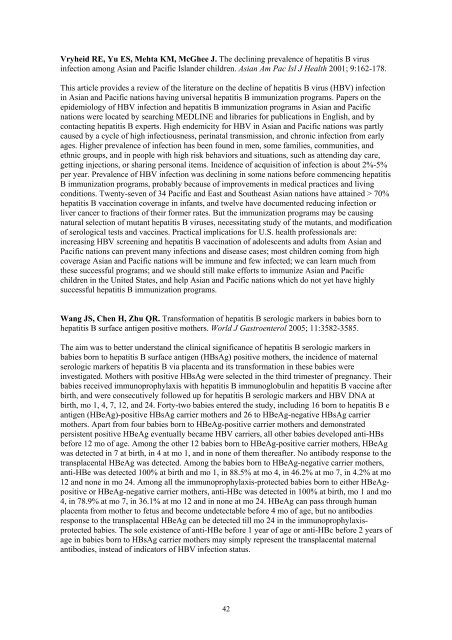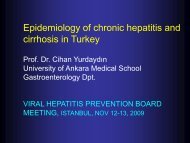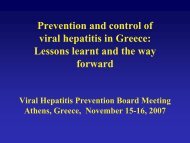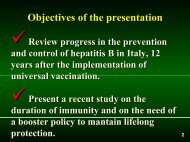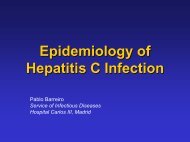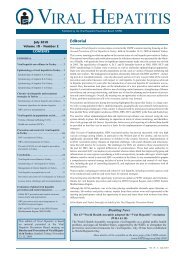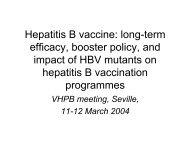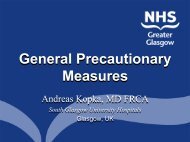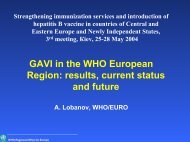Prevention and control of perinatal hepatitis B virus transmission in ...
Prevention and control of perinatal hepatitis B virus transmission in ...
Prevention and control of perinatal hepatitis B virus transmission in ...
You also want an ePaper? Increase the reach of your titles
YUMPU automatically turns print PDFs into web optimized ePapers that Google loves.
Vryheid RE, Yu ES, Mehta KM, McGhee J. The decl<strong>in</strong><strong>in</strong>g prevalence <strong>of</strong> <strong>hepatitis</strong> B <strong>virus</strong><strong>in</strong>fection among Asian <strong>and</strong> Pacific Isl<strong>and</strong>er children. Asian Am Pac Isl J Health 2001; 9:162-178.This article provides a review <strong>of</strong> the literature on the decl<strong>in</strong>e <strong>of</strong> <strong>hepatitis</strong> B <strong>virus</strong> (HBV) <strong>in</strong>fection<strong>in</strong> Asian <strong>and</strong> Pacific nations hav<strong>in</strong>g universal <strong>hepatitis</strong> B immunization programs. Papers on theepidemiology <strong>of</strong> HBV <strong>in</strong>fection <strong>and</strong> <strong>hepatitis</strong> B immunization programs <strong>in</strong> Asian <strong>and</strong> Pacificnations were located by search<strong>in</strong>g MEDLINE <strong>and</strong> libraries for publications <strong>in</strong> English, <strong>and</strong> bycontact<strong>in</strong>g <strong>hepatitis</strong> B experts. High endemicity for HBV <strong>in</strong> Asian <strong>and</strong> Pacific nations was partlycaused by a cycle <strong>of</strong> high <strong>in</strong>fectiousness, <strong>per<strong>in</strong>atal</strong> <strong>transmission</strong>, <strong>and</strong> chronic <strong>in</strong>fection from earlyages. Higher prevalence <strong>of</strong> <strong>in</strong>fection has been found <strong>in</strong> men, some families, communities, <strong>and</strong>ethnic groups, <strong>and</strong> <strong>in</strong> people with high risk behaviors <strong>and</strong> situations, such as attend<strong>in</strong>g day care,gett<strong>in</strong>g <strong>in</strong>jections, or shar<strong>in</strong>g personal items. Incidence <strong>of</strong> acquisition <strong>of</strong> <strong>in</strong>fection is about 2%-5%per year. Prevalence <strong>of</strong> HBV <strong>in</strong>fection was decl<strong>in</strong><strong>in</strong>g <strong>in</strong> some nations before commenc<strong>in</strong>g <strong>hepatitis</strong>B immunization programs, probably because <strong>of</strong> improvements <strong>in</strong> medical practices <strong>and</strong> liv<strong>in</strong>gconditions. Twenty-seven <strong>of</strong> 34 Pacific <strong>and</strong> East <strong>and</strong> Southeast Asian nations have atta<strong>in</strong>ed > 70%<strong>hepatitis</strong> B vacc<strong>in</strong>ation coverage <strong>in</strong> <strong>in</strong>fants, <strong>and</strong> twelve have documented reduc<strong>in</strong>g <strong>in</strong>fection orliver cancer to fractions <strong>of</strong> their former rates. But the immunization programs may be caus<strong>in</strong>gnatural selection <strong>of</strong> mutant <strong>hepatitis</strong> B <strong>virus</strong>es, necessitat<strong>in</strong>g study <strong>of</strong> the mutants, <strong>and</strong> modification<strong>of</strong> serological tests <strong>and</strong> vacc<strong>in</strong>es. Practical implications for U.S. health pr<strong>of</strong>essionals are:<strong>in</strong>creas<strong>in</strong>g HBV screen<strong>in</strong>g <strong>and</strong> <strong>hepatitis</strong> B vacc<strong>in</strong>ation <strong>of</strong> adolescents <strong>and</strong> adults from Asian <strong>and</strong>Pacific nations can prevent many <strong>in</strong>fections <strong>and</strong> disease cases; most children com<strong>in</strong>g from highcoverage Asian <strong>and</strong> Pacific nations will be immune <strong>and</strong> few <strong>in</strong>fected; we can learn much fromthese successful programs; <strong>and</strong> we should still make efforts to immunize Asian <strong>and</strong> Pacificchildren <strong>in</strong> the United States, <strong>and</strong> help Asian <strong>and</strong> Pacific nations which do not yet have highlysuccessful <strong>hepatitis</strong> B immunization programs.Wang JS, Chen H, Zhu QR. Transformation <strong>of</strong> <strong>hepatitis</strong> B serologic markers <strong>in</strong> babies born to<strong>hepatitis</strong> B surface antigen positive mothers. World J Gastroenterol 2005; 11:3582-3585.The aim was to better underst<strong>and</strong> the cl<strong>in</strong>ical significance <strong>of</strong> <strong>hepatitis</strong> B serologic markers <strong>in</strong>babies born to <strong>hepatitis</strong> B surface antigen (HBsAg) positive mothers, the <strong>in</strong>cidence <strong>of</strong> maternalserologic markers <strong>of</strong> <strong>hepatitis</strong> B via placenta <strong>and</strong> its transformation <strong>in</strong> these babies were<strong>in</strong>vestigated. Mothers with positive HBsAg were selected <strong>in</strong> the third trimester <strong>of</strong> pregnancy. Theirbabies received immunoprophylaxis with <strong>hepatitis</strong> B immunoglobul<strong>in</strong> <strong>and</strong> <strong>hepatitis</strong> B vacc<strong>in</strong>e afterbirth, <strong>and</strong> were consecutively followed up for <strong>hepatitis</strong> B serologic markers <strong>and</strong> HBV DNA atbirth, mo 1, 4, 7, 12, <strong>and</strong> 24. Forty-two babies entered the study, <strong>in</strong>clud<strong>in</strong>g 16 born to <strong>hepatitis</strong> B eantigen (HBeAg)-positive HBsAg carrier mothers <strong>and</strong> 26 to HBeAg-negative HBsAg carriermothers. Apart from four babies born to HBeAg-positive carrier mothers <strong>and</strong> demonstratedpersistent positive HBeAg eventually became HBV carriers, all other babies developed anti-HBsbefore 12 mo <strong>of</strong> age. Among the other 12 babies born to HBeAg-positive carrier mothers, HBeAgwas detected <strong>in</strong> 7 at birth, <strong>in</strong> 4 at mo 1, <strong>and</strong> <strong>in</strong> none <strong>of</strong> them thereafter. No antibody response to thetransplacental HBeAg was detected. Among the babies born to HBeAg-negative carrier mothers,anti-HBe was detected 100% at birth <strong>and</strong> mo 1, <strong>in</strong> 88.5% at mo 4, <strong>in</strong> 46.2% at mo 7, <strong>in</strong> 4.2% at mo12 <strong>and</strong> none <strong>in</strong> mo 24. Among all the immunoprophylaxis-protected babies born to either HBeAgpositiveor HBeAg-negative carrier mothers, anti-HBc was detected <strong>in</strong> 100% at birth, mo 1 <strong>and</strong> mo4, <strong>in</strong> 78.9% at mo 7, <strong>in</strong> 36.1% at mo 12 <strong>and</strong> <strong>in</strong> none at mo 24. HBeAg can pass through humanplacenta from mother to fetus <strong>and</strong> become undetectable before 4 mo <strong>of</strong> age, but no antibodiesresponse to the transplacental HBeAg can be detected till mo 24 <strong>in</strong> the immunoprophylaxisprotectedbabies. The sole existence <strong>of</strong> anti-HBe before 1 year <strong>of</strong> age or anti-HBc before 2 years <strong>of</strong>age <strong>in</strong> babies born to HBsAg carrier mothers may simply represent the transplacental maternalantibodies, <strong>in</strong>stead <strong>of</strong> <strong>in</strong>dicators <strong>of</strong> HBV <strong>in</strong>fection status.42


